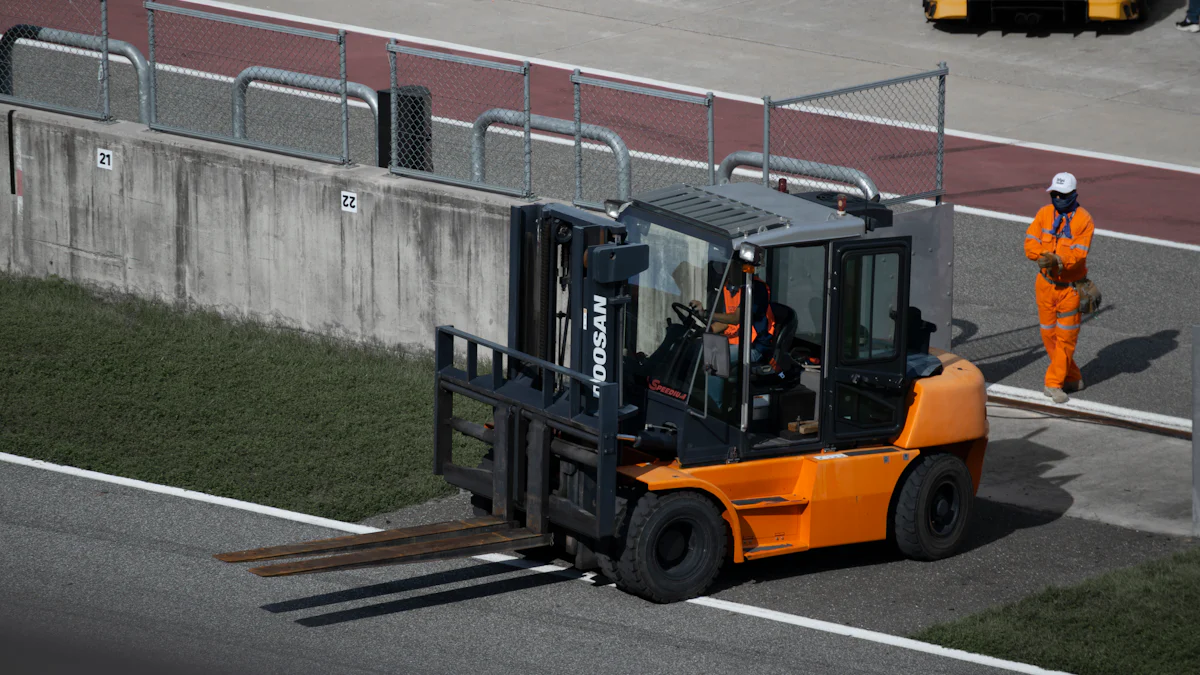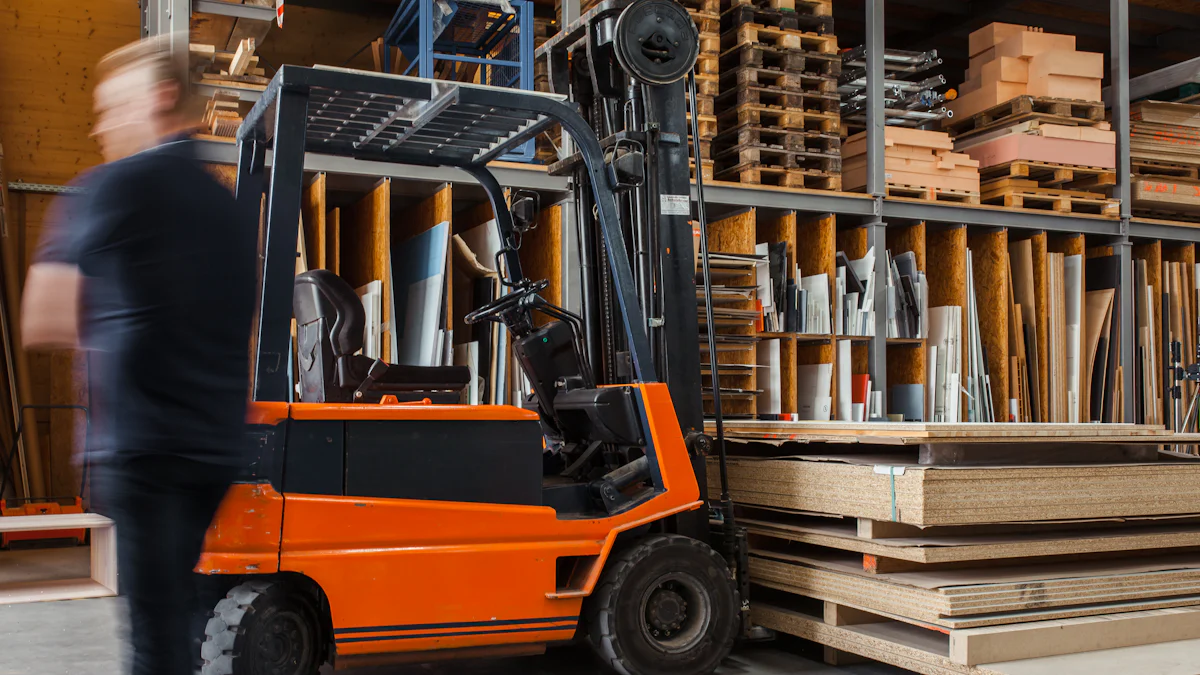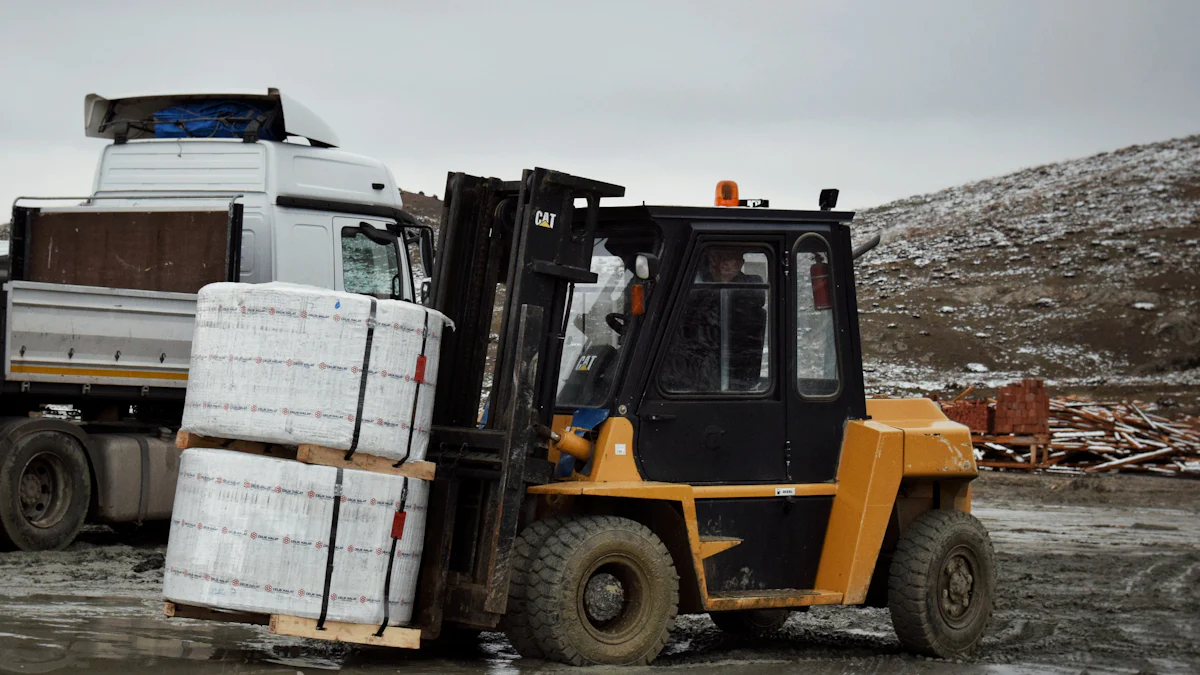
Diesel forklifts and pallet jacks play a crucial role in various industries. Understanding the specifications of these machines ensures optimal performance and safety. This guide aims to provide comprehensive insights into the diesel forklift 3 ton lifting 4500mm, helping businesses make informed decisions.
Understanding Diesel Forklifts
What is a Diesel Forklift?
Definition and Basic Components
A diesel forklift operates using an internal combustion engine powered by diesel fuel. The primary components include the engine, hydraulic lift system, counterweight, and operator’s cabin. The engine generates power to lift and move heavy loads. The hydraulic system facilitates smooth lifting and lowering of materials. The counterweight ensures stability during operations. The operator’s cabin provides a safe and ergonomic environment for the driver.
Advantages of Diesel Forklifts
Diesel forklifts offer several advantages over other types of forklifts. These machines deliver high power output, making them suitable for heavy-duty tasks. The continuous operation efficiency stands out because refueling takes less time than recharging electric models. Diesel engines provide robust performance in outdoor environments, handling rough terrains with ease. The durability and longevity of diesel engines reduce the frequency of replacements and major repairs.
General Uses of Diesel Forklifts
Industrial Applications
Diesel forklifts excel in various industrial applications. These machines handle heavy loads in construction sites, manufacturing plants, and steel mills. The high lifting capacity and rugged design make them ideal for transporting bulky materials. Industries rely on these forklifts for tasks such as loading and unloading trucks, moving raw materials, and positioning heavy equipment.
Warehousing and Logistics
In warehousing and logistics, diesel forklifts play a crucial role. These machines streamline operations by efficiently moving goods within large storage facilities. The ability to lift up to 4500mm enhances vertical storage capabilities. Warehouses use these forklifts for stacking pallets, organizing inventory, and loading goods onto delivery vehicles. The reliability and power of diesel engines ensure uninterrupted workflow in busy logistics centers.
Key Specifications

Lifting Capacity
Importance of 3-ton capacity
A diesel forklift 3 ton lifting 4500mm offers a versatile solution for various industries. The 3-ton capacity allows the forklift to handle substantial loads without compromising maneuverability. This capacity suits indoor applications where space constraints exist. The ability to lift 3 tons ensures efficient material handling in warehouses, retail environments, and small-scale industrial operations.
Comparison with other capacities
Comparing the 3-ton capacity to higher capacities like 3.5 tons reveals distinct advantages. A 3.5-ton forklift handles heavier loads and suits outdoor applications. However, the 3-ton forklift excels in indoor settings due to its compact design. Industries such as warehousing and logistics prefer the 3-ton model for its balance between power and size. The 3.5-ton forklift, while powerful, may not offer the same level of maneuverability in confined spaces.
Load Center Distance
Definition and significance
The load center distance refers to the horizontal distance from the front face of the forks to the center of gravity of the load. For a diesel forklift 3 ton lifting 4500mm, this distance typically measures around 500 mm. Understanding the load center distance is crucial for maintaining stability during lifting operations. A proper load center distance ensures that the forklift can safely handle its rated capacity without tipping over.
Impact on lifting capacity
The load center distance directly impacts the lifting capacity of the forklift. A longer load center distance reduces the effective lifting capacity. Conversely, a shorter load center distance allows the forklift to handle heavier loads. Operators must consider the load center distance when planning lifts to ensure safety and efficiency. Properly balanced loads within the specified load center distance optimize the forklift’s performance.
Lift Height
Maximum lift height of 4500mm
The diesel forklift 3 ton lifting 4500mm offers a maximum lift height of 4500 mm. This height capability enhances vertical storage options in warehouses and industrial settings. The ability to lift loads to such heights maximizes storage space utilization. Forklifts with this lift height can efficiently stack pallets and materials on high shelves, improving overall storage efficiency.
Scenarios requiring high lift
Several scenarios benefit from the high lift capability of 4500 mm. Warehouses with tall storage racks utilize this feature to maximize vertical space. Construction sites often require lifting materials to elevated platforms or scaffolding. The high lift height also proves useful in manufacturing plants where machinery and equipment need precise positioning. The versatility of the diesel forklift 3 ton lifting 4500mm makes it an invaluable asset in these demanding environments.
Engine Types and Performance
Types of Diesel Engines
Common Engine Models
Diesel forklifts often feature engines from renowned manufacturers. Popular models include Yanmar, ISUZU, XINCHAI, Mitsubishi, and Toyota. Each engine model offers unique benefits tailored to different operational needs. For instance, Yanmar engines are known for their reliability and low noise levels. ISUZU engines provide robust performance and durability. XINCHAI engines offer cost-effective solutions without compromising quality. Mitsubishi and Toyota engines deliver high power output and efficiency.
Fuel Efficiency and Emissions
Fuel efficiency remains a critical factor in diesel forklift operations. Modern diesel engines incorporate advanced technologies to optimize fuel consumption. Efficient fuel use reduces operational costs and minimizes environmental impact. Emission standards have become stricter, prompting manufacturers to develop cleaner engines. Many diesel forklifts now meet Tier 4 emission standards, ensuring reduced harmful emissions. This compliance not only benefits the environment but also enhances workplace safety.
Performance Metrics
Power Output
Power output determines the forklift’s ability to handle heavy loads. Diesel engines typically offer higher power output compared to electric models. For example, some TCM models deliver 44.0 kW at 2300 r.p.m. High power output ensures efficient lifting and transportation of materials. This capability proves essential in demanding industrial environments where heavy-duty tasks are common.
Torque and Acceleration
Torque plays a vital role in a forklift’s performance. Higher torque allows the forklift to accelerate quickly, even under heavy loads. Diesel engines excel in providing substantial torque, making them suitable for rugged terrains and challenging conditions. Quick acceleration enhances productivity by reducing cycle times. Operators can complete tasks faster, improving overall workflow efficiency.
Expert Testimony:
“Tuned for high performance, the engine, hydrostatic drive, and proprietary Linde Load Control lift system work to create an efficient, powerful machine,” says an Expert in Linde Forklifts. “The whole range boasts impressive lifting capacity, but the Linde H80D has the largest capacity, at over 8 tons.”
This expert insight highlights the importance of engine performance in achieving high lifting capacities. Diesel forklifts, with their powerful engines and advanced systems, ensure reliable and efficient operations across various industries.
Common Features and Configurations

Standard Features
Safety Features
Diesel forklifts come equipped with essential safety features to protect operators and bystanders. These machines often include:
- Overhead guards to shield operators from falling objects.
- Seat belts to secure operators during operation.
- Backup alarms to alert others when the forklift moves in reverse.
- Strobe lights to enhance visibility in low-light conditions.
- Load backrests to prevent loads from shifting backward.
Manufacturers like Linde focus on creating environmentally friendly forklifts that also prioritize safety. Their comprehensive sustainability strategy includes reducing emissions and fuel consumption, contributing to a safer working environment.
Ergonomic Design
Ergonomic design plays a crucial role in enhancing operator comfort and productivity. Key ergonomic features of diesel forklifts include:
- Adjustable seats with lumbar support to reduce operator fatigue.
- Tilt steering columns to accommodate different operator preferences.
- Easy-to-reach controls for efficient operation.
- Anti-vibration systems to minimize operator discomfort during extended use.
These features ensure that operators can work efficiently and comfortably, reducing the risk of strain and injury.
Optional Configurations
Attachments and Accessories
Diesel forklifts offer a variety of attachments and accessories to enhance their versatility. Common attachments include:
- Side shifters to move loads laterally without repositioning the forklift.
- Fork positioners to adjust fork spacing for different load sizes.
- Rotators to rotate loads for dumping or repositioning.
- Clamps to handle non-palletized loads like drums or bales.
These attachments allow forklifts to perform a wide range of tasks, making them indispensable in various industries.
Customization Options
Customization options enable businesses to tailor diesel forklifts to their specific needs. Customization may involve:
- Specialized tires for different terrains, such as solid or pneumatic tires.
- Cab enclosures with heating and air conditioning for extreme weather conditions.
- Advanced telematics systems for monitoring forklift performance and maintenance needs.
- Custom paint and branding to match company colors and logos.
These options ensure that each forklift meets the unique requirements of its operating environment, enhancing efficiency and productivity.
Expert Insight:
“Linde’s EVO forklifts are recognized for their environmental friendliness and advanced features,” says an industry expert. “These machines achieve significant reductions in fuel consumption and emissions, making them a top choice for businesses prioritizing sustainability.”
The combination of standard safety features, ergonomic design, versatile attachments, and customization options makes diesel forklifts a valuable asset in various industrial settings.
Transmission Options
Manual vs. Automatic
Pros and Cons of Each
Manual transmissions offer precise control over the forklift’s movements. Operators can select gears based on load requirements. This option provides better fuel efficiency in certain conditions. However, manual transmissions require more skill and can lead to operator fatigue.
Automatic transmissions simplify operation. The system automatically selects the appropriate gear. This reduces the need for constant adjustments. Automatic transmissions enhance operator comfort and reduce training time. However, these systems can be more expensive and may consume more fuel.
Suitability for Different Tasks
Manual transmissions suit tasks requiring precise control. Construction sites often benefit from manual options. These environments demand careful maneuvering. Manual transmissions also excel in applications with varied load weights.
Automatic transmissions work well in repetitive tasks. Warehousing and logistics operations often prefer automatic systems. These tasks involve frequent stops and starts. Automatic transmissions reduce operator strain and increase productivity.
Maintenance Considerations
Routine Maintenance Tips
Regular maintenance ensures optimal forklift performance. Operators should check fluid levels daily. Hydraulic fluid, engine oil, and coolant require regular monitoring. Tire pressure and condition also need frequent inspection. Cleaning air filters and replacing them as needed maintains engine efficiency.
Scheduled servicing by professionals is essential. Manufacturers provide maintenance schedules. Following these guidelines prevents major issues. Regularly inspecting hoses and belts helps identify wear early. Lubricating moving parts reduces friction and extends lifespan.
Common Issues and Solutions
Forklifts may experience common issues. Engine overheating often results from low coolant levels. Regularly checking and refilling coolant prevents this problem. Hydraulic system leaks can occur. Inspecting hoses and seals regularly helps detect leaks early.
Transmission problems may arise. Low fluid levels often cause these issues. Regularly checking and maintaining fluid levels prevents transmission failures. Electrical issues can affect forklift performance. Inspecting wiring and connections ensures reliable operation.
Expert Insight:
“Routine maintenance significantly extends the lifespan of forklifts,” says a maintenance expert. “Addressing small issues early prevents costly repairs and downtime.”
Proper maintenance practices ensure diesel forklifts remain reliable and efficient. Regular inspections and timely servicing keep operations running smoothly.
Pricing and Applications
Cost Factors
New vs. Used Forklifts
Purchasing a new diesel forklift offers several benefits. New models come with the latest technology and features, ensuring optimal performance and safety. Manufacturers provide warranties that cover repairs and replacements. However, new forklifts come at a higher initial cost.
Used diesel forklifts present a cost-effective alternative. These machines often come at a fraction of the price of new models. Businesses can find well-maintained used forklifts that perform reliably. However, used forklifts may require more frequent maintenance. The lack of a warranty can lead to higher repair costs over time.
Additional Costs (Maintenance, Fuel)
Operating a diesel forklift involves ongoing expenses. Maintenance costs include routine servicing and parts replacement. Regular checks on fluid levels, tires, and hydraulic systems ensure smooth operation. Diesel forklifts require periodic engine tune-ups and filter changes.
Fuel costs also contribute to the overall expense. Diesel fuel prices fluctuate, impacting operational budgets. Diesel engines offer higher continuous operation efficiency compared to electric models. Refueling takes less time than recharging electric forklifts. This efficiency can offset some of the fuel costs.
Customer Testimonial:
“It is easy to see that diesel forklifts have a higher continuous operation efficiency than electric forklifts because customers just need to add fuel then can continue to operate, while electric forklifts need time to recharge. After using for about 6-7 years, diesel forklifts require more frequent maintenance and replacement of worn and damaged parts to be able to operate effectively.”
Versatility and Use Cases
Industries Benefiting from 3-Ton Forklifts
Several industries benefit from using 3-ton diesel forklifts. Warehousing and logistics operations rely on these machines for efficient material handling. The 3-ton capacity suits indoor environments with space constraints. Retail environments use these forklifts for stocking shelves and moving inventory.
Construction sites also benefit from 3-ton diesel forklifts. These machines handle heavy loads and navigate rough terrains. Manufacturing plants use 3-ton forklifts for transporting raw materials and finished products. The versatility of these forklifts makes them suitable for various applications.
Real-World Examples
Real-world examples highlight the effectiveness of 3-ton diesel forklifts. A large warehouse uses these forklifts to stack pallets up to 4500mm high. This capability maximizes vertical storage space. A construction company employs 3-ton forklifts to move building materials across uneven ground. The robust design and high power output ensure reliable performance.
A retail chain utilizes 3-ton forklifts in distribution centers. These machines streamline the process of loading and unloading delivery trucks. The forklifts’ compact size allows easy maneuvering in confined spaces. These examples demonstrate the practical applications of 3-ton diesel forklifts in diverse settings.
- Recap of key points
The guide covered essential aspects of the diesel forklift 3-ton lifting 4500mm. Key specifications, engine types, performance metrics, and common features were discussed. The blog also highlighted transmission options, maintenance considerations, pricing, and applications.
- Final thoughts on choosing a 3-ton diesel forklift
Choosing a 3-ton diesel forklift requires careful consideration of operational needs. Businesses should evaluate lifting capacity, load center distance, and lift height. Engine performance and fuel efficiency are crucial factors. Safety features and ergonomic design enhance operator comfort and productivity.
- Encouragement to consider specific needs and consult experts
Businesses must align forklift specifications with their specific requirements. Consulting industry experts ensures informed decisions. LiftOne’s experienced mechanics recommend regular maintenance to extend equipment lifespan. Addressing small issues early prevents costly repairs and downtime.
Post time: Jul-08-2024
